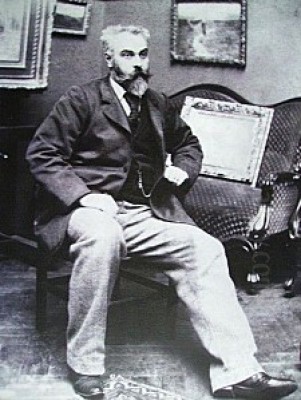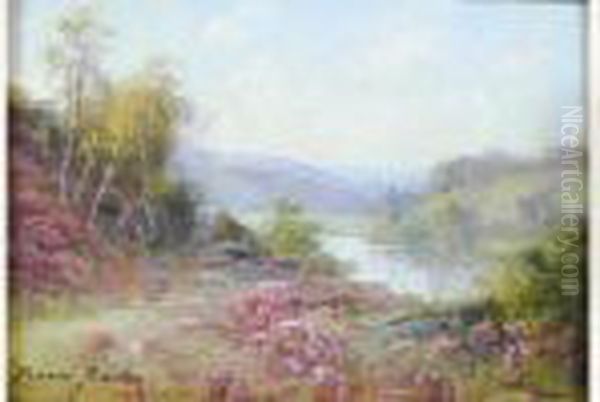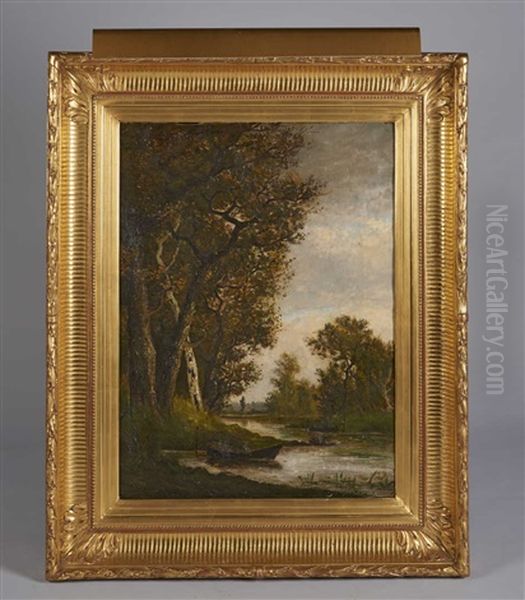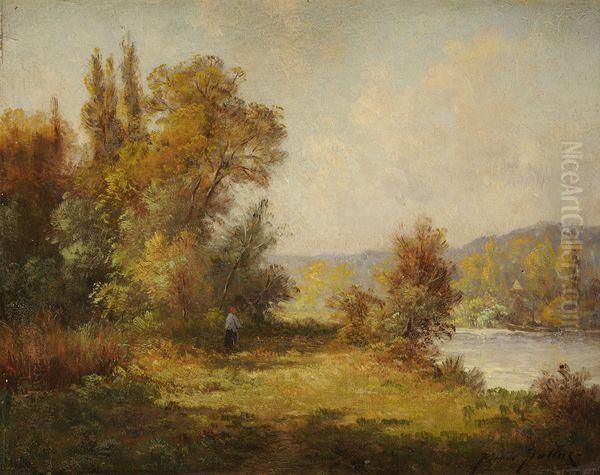
Pierre-Ernest Ballue (1855-1928) was a French artist whose life and career spanned a period of profound transformation in the art world. Active primarily as a landscape painter, Ballue's work reflects the enduring appeal of nature as a subject, interpreted through the lens of late 19th and early 20th-century artistic sensibilities. While not as widely known as some of his revolutionary contemporaries, his paintings offer a valuable glimpse into the artistic currents that flowed between established traditions and emerging modernism. His dedication to capturing the nuances of the French countryside, particularly its forests and waterways, places him within a lineage of artists devoted to the direct observation and personal expression of the natural world.
The Artistic Milieu of Late 19th-Century France
To understand Pierre-Ernest Ballue's artistic journey, it is essential to consider the vibrant and often tumultuous artistic environment of France during his formative and active years. The latter half of the 19th century was a crucible of innovation. The entrenched academicism of the École des Beaux-Arts, with its emphasis on historical, mythological, and religious subjects rendered with polished precision, was increasingly challenged. Artists began to seek new modes of expression and new subject matter, turning their gaze towards contemporary life and the unadorned beauty of the landscape.
The Barbizon School, which flourished from the 1830s to the 1870s, had already laid significant groundwork for this shift. Painters like Jean-Baptiste-Camille Corot, Théodore Rousseau, Jean-François Millet, and Charles-François Daubigny rejected the idealized landscapes of Neoclassicism, opting instead to paint directly from nature (en plein air) in the Forest of Fontainebleau and surrounding villages. Their work emphasized atmosphere, light, and a more truthful depiction of rural life and scenery. This movement had a lasting impact, fostering a greater appreciation for landscape painting as a genre in its own right.

Following in their wake, Realism, championed by figures such as Gustave Courbet, further pushed for art to depict the world as it was, without idealization or romantic sentimentality. Courbet's bold pronouncements and unvarnished portrayals of ordinary people and landscapes challenged the artistic establishment. This emphasis on truth to nature and contemporary experience resonated deeply with many younger artists.
By the time Ballue was embarking on his career, Impressionism had exploded onto the Parisian art scene. Artists like Claude Monet, Camille Pissarro, Alfred Sisley, and Pierre-Auguste Renoir sought to capture the fleeting effects of light and color, often painting outdoors with rapid, broken brushstrokes. Their focus on subjective perception and the ephemeral qualities of the moment was revolutionary and initially met with considerable scorn, but eventually transformed the course of Western art.
The late 19th century also saw the rise of Post-Impressionism, with artists such as Paul Cézanne, Vincent van Gogh, and Paul Gauguin building upon Impressionist innovations but pushing in more individualistic directions, emphasizing structure, emotion, and symbolism. Simultaneously, Symbolism as a broader literary and artistic movement gained traction, encouraging artists to explore inner worlds, dreams, and mystical themes, often through evocative and non-literal imagery. Figures like Odilon Redon and Gustave Moreau were prominent in this vein. The artistic landscape was thus a rich tapestry of competing and coexisting styles, offering a diverse range of influences for an emerging painter like Ballue.
Ballue's Artistic Focus: Landscapes of Forest and River
Pierre-Ernest Ballue established himself primarily as a painter of landscapes. His preferred subjects were the tranquil and often intimate scenes of nature, with a particular fondness for forests and rivers. This thematic choice aligns him with the Barbizon tradition and the broader 19th-century appreciation for the French countryside. His works, typically executed in oil on canvas or wood panel, aimed to convey the specific character and atmosphere of the locations he depicted.
His approach appears to have been rooted in careful observation, likely involving outdoor sketching and studies, a practice popularized by the Barbizon painters and continued by the Impressionists. The rendering of light and its interplay with the natural forms—trees, water, sky—would have been a central concern. While the provided information doesn't delve deeply into the specific evolution of his technique, artists of this period working in landscape often sought a balance between topographical accuracy and personal, expressive interpretation.

The late 19th and early 20th centuries saw landscape painting move beyond mere representation. Artists increasingly used nature as a vehicle for conveying mood, emotion, or a sense of place imbued with personal significance. Ballue's work, emerging in this context, likely partook in this trend, aiming to create not just a picture of a place, but an experience of it. His paintings would have sought to capture the quietude of a forest interior, the reflective surface of a slow-moving river, or the particular light of a specific time of day or season.
Notable Works and Their Characteristics
Several works by Pierre-Ernest Ballue provide insight into his artistic output and preoccupations. Among his representative pieces is Paysage de forêt (Forest Landscape). This oil painting, measuring 32 x 24 centimeters, exemplifies his focus on woodland scenes. The relatively modest dimensions suggest it could have been an intimate studio piece or perhaps a more finished work based on outdoor studies. Its auction estimate of 300 to 400 euros indicates a recognized, if not premier, position in the art market for works of this nature.
Another painting, titled Clisson, further demonstrates his engagement with specific French locales. Clisson, a town in the Loire-Atlantique department known for its Italianate architecture and picturesque setting, would have offered rich subject matter for a landscape painter. This work was estimated at auction between 150 and 200 euros. The existence of a piece titled Bord de rivière (Riverbank), even if unsigned, reinforces his attraction to riparian scenes, a classic theme in landscape art that allows for explorations of reflection, light, and the meeting of land and water.
A more significant piece in terms of market value appears to be La Seine à Triel, matinée d'automne (The Seine at Triel, Autumn Morning). This painting, depicting the famous river in an autumnal setting near the town of Triel, fetched between 3000 and 4000 euros. The title itself evokes a specific time and atmosphere, suggesting a concern with capturing the nuanced light and colors of an autumn morning, a favorite subject for many landscape painters, including Impressionists like Monet and Pissarro who extensively painted the Seine.

Perhaps one of the most contextually significant mentions is his work Village sur la colline (Village on the Hill). This painting was notably included in an exhibition titled "L'École de Barbizon: La Peinture Française du XIXᵉ Siècle" (The Barbizon School: French Painting of the 19th Century). Its inclusion in such an exhibition, even if Ballue was of a later generation than the core Barbizon masters, suggests that his work was seen as carrying on the spirit or stylistic tendencies of that influential school. This could imply a commitment to naturalism, an emphasis on rural scenery, and a certain tonal quality often associated with Barbizon art.
Exhibitions, Recognition, and Market Presence
The available information indicates that Pierre-Ernest Ballue's works were exhibited in various contexts, contributing to his recognition as an artist. The inclusion of Village sur la colline in "L'École de Barbizon: La Peinture Française du XIXᵉ Siècle" is a noteworthy event, as it places his work within a respected art historical framework and suggests an affinity with the aims and aesthetics of the Barbizon painters. Such exhibitions serve to contextualize an artist's work and introduce it to a wider audience.
His paintings have also appeared at public auctions, which is a common way for works by historical artists to be circulated and valued. The prices achieved, such as those for Paysage de forêt, Clisson, and particularly La Seine à Triel, matinée d'automne, provide a snapshot of his market standing among collectors of French landscape painting from this period. While not reaching the astronomical figures of the era's leading names, these prices indicate a consistent appreciation for his skill and artistic vision.
An interesting, though perhaps indirect, connection to the public display of art is the mention of exhibitions held at the Jardins de la Ballue (Ballue Gardens). While the exact relationship of the painter to these specific gardens isn't fully elucidated in the provided material (whether by family connection or thematic inspiration), the fact that art exhibitions were held there, free to the public, speaks to a culture of art appreciation. The Jardins de la Ballue themselves gained recognition, receiving a European Garden Award, highlighting the aesthetic importance of designed landscapes, a field that often intersects with landscape painting.
Contemporaries and Potential Influences
Pierre-Ernest Ballue practiced his art during a period rich with diverse talents. While direct collaborations are not documented, an artist invariably absorbs and reacts to the prevailing artistic currents and the work of their peers. His contemporaries included a wide spectrum of painters. The Barbizon painters, though mostly active before Ballue's prime, would have cast a long shadow. The aforementioned Corot, Rousseau, Millet, and Daubigny, along with others like Constant Troyon, known for his animal and landscape scenes, and Narcisse Virgilio Díaz de la Peña, famed for his richly colored forest interiors, established a strong tradition of naturalistic landscape.
The Impressionists, his direct contemporaries, revolutionized the depiction of light and atmosphere. While Ballue's style, based on titles like Paysage de forêt and its association with Barbizon exhibitions, might lean more towards a pre-Impressionist or a more tempered Impressionistic sensibility, he would undoubtedly have been aware of the work of Monet, Pissarro, Sisley, and Renoir. Their emphasis on capturing the immediate visual sensation and the effects of changing light could have subtly informed his own approach to landscape.
Other landscape painters of the late 19th century also contributed to the artistic environment. For instance, Eugène Boudin, a mentor to Monet, was renowned for his delicate marine and sky paintings. Artists like Henri Harpignies continued the Barbizon tradition well into the 20th century with a strong, structured approach to landscape. The provided information also lists Jean Charles Joseph de Flandre, Eugène Louis Lami (known more for historical scenes and watercolors of elegant society, but also a skilled observer), and Charles Léopold Questier as artists active during similar periods, reflecting the diversity of the art scene.
The broader shift towards a more personal and expressive engagement with nature, moving away from purely academic or topographical representation, was a hallmark of the era. Ballue's focus on specific locales and atmospheric conditions suggests he was part of this wider movement that saw landscape painting as a means of conveying both the external reality of a place and the artist's internal response to it. His work likely absorbed these influences, resulting in landscapes that were both descriptive and evocative.
Personal Life and Anecdotes: A Scarcity of Detail
Unlike some of his more famous contemporaries whose lives are extensively documented, detailed biographical information, personal anecdotes, or specific insights into the daily life of Pierre-Ernest Ballue, the painter, are not readily available in the provided sources. The art historical record often prioritizes artists who were central to major movements or who left behind extensive personal archives. For many competent and dedicated artists like Ballue, who contributed steadily to the artistic fabric of their time without necessarily spearheading a revolution, personal details can be more elusive.
It is important to distinguish Pierre-Ernest Ballue, the painter (1855-1928), from other historical figures who might share similar names. For instance, the provided information briefly touches upon a Pierre-Ernest de Mansfeld, a 16th-century governor, and a "Péronne incident" related to French satire. These are interesting historical footnotes but appear to have no direct bearing on the life or work of the landscape painter Pierre-Ernest Ballue. Such distinctions are crucial for maintaining historical accuracy.
The absence of detailed personal narratives does not diminish the value of Ballue's artistic contributions. His legacy resides primarily in his canvases – the forests, rivers, and villages he chose to depict. These works speak for themselves, offering a quiet testament to his dedication to the art of landscape painting and his engagement with the natural beauty of France.
Legacy and Conclusion
Pierre-Ernest Ballue was a French painter who dedicated his career to the art of landscape. Active from the latter part of the 19th century into the early 20th century, he worked within a tradition that valued the direct observation of nature, yet also coincided with a period of immense artistic experimentation. His paintings of forests, rivers, and rural scenes, such as Paysage de forêt, Clisson, and La Seine à Triel, matinée d'automne, reflect a commitment to capturing the specific character and atmosphere of the French countryside.
His connection, through works like Village sur la colline, to exhibitions focusing on the Barbizon School suggests an affinity with their naturalistic ethos and their elevation of landscape as a worthy subject for serious artistic endeavor. While perhaps not an innovator on the scale of the Impressionists or Post-Impressionists, Ballue contributed to the rich tapestry of French painting during his era. His works found a place in exhibitions and continue to be appreciated in the art market, indicating a sustained recognition of their quality and charm.
As an artist working through a period of transition, Ballue's paintings likely synthesized elements of established landscape traditions with the newer sensibilities that emphasized personal expression and the atmospheric qualities of nature. He remains a figure representative of the many skilled artists who, while not always in the vanguard of radical change, diligently pursued their craft, leaving behind a body of work that enriches our understanding of the artistic currents of their time and offers enduring visual pleasure. His paintings serve as quiet windows onto the French landscape as he saw and interpreted it, a valuable contribution to the enduring genre of landscape art.